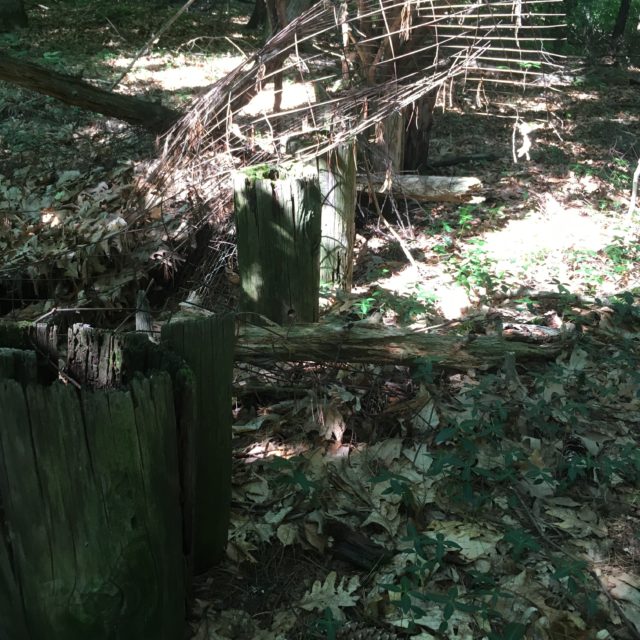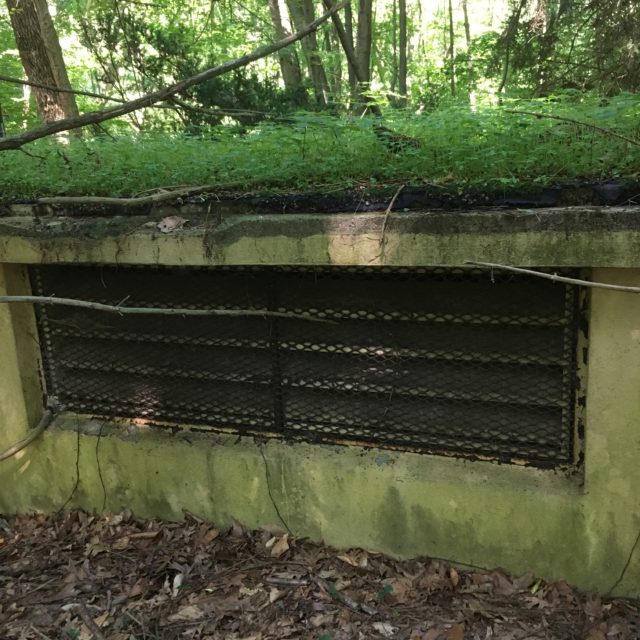Using the Barbour entrance to Keney Park off Tower Avenue, you’ll notice two paved roads, one of which is gated shut. There is/was a third road, on the left — the Sylvan Court Trail — that has been overtaken by nature. This unmarked trail leads to the site of Sherwood Forest, a 12-acre zoo that operated in Hartford from 1963-1976. The reasons given for closure were vandalism and low visitation, but news articles from the time also cited operating costs. At $60,000 per year, with no regional support, it made no sense to continue with the venture that only produced, toward the end, around $5,000 annual revenue. How could anything be maintained, secured, or promoted with those conditions?
 The zoo’s remnants are within the Ten Mile Woods, a delightful name for a part of Keney Park surrounded by a residential area of Bloomfield and the Matianuck Sand Dunes Natural Area Preserve in Windsor. It has gone wild. That any path is visible is evidence of walkers and mountain bikers exploring the area on occasion. The area could be in worse shape, perhaps protected against the plague of illegal dumping by the number of fallen trees, mushy ground, and thick mosquitoes.
The zoo’s remnants are within the Ten Mile Woods, a delightful name for a part of Keney Park surrounded by a residential area of Bloomfield and the Matianuck Sand Dunes Natural Area Preserve in Windsor. It has gone wild. That any path is visible is evidence of walkers and mountain bikers exploring the area on occasion. The area could be in worse shape, perhaps protected against the plague of illegal dumping by the number of fallen trees, mushy ground, and thick mosquitoes.
Today, a single grill remains in what was a picnic area, and is the only hint as to what that section had been used for over forty years ago. The comfort station had been unofficially repurposed as a shelter; stall doors and fixtures have been ripped out and left scattered around the site. Sneakers and a boombox litter the ground nearby.
There are no signs pointing out what anything was, or even that this had been a zoo. If you didn’t know what you were looking at, it might take a few guesses before figuring it out.

Before its opening, newspaper pieces warned that zoos with too few animals do not attract enough visitors to remain financially solvent. Following its closure, when attempts were made to re-establish the zoo during the mid-to-late 1970s, the Connecticut Humane Society opposed the measure, citing a number of problems observed at Sherwood Forest, from stagnant pools of water to an absence of double fencing that would have provided more of a buffer between animals and visitors, preventing the harassment and killing of animals.
Before Sherwood Forest, there was a smaller zoo in Colt Park. In 1929, the conditions there were deemed “unsatisfactory” and allocating enough budget for improvements was deemed fiscally irresponsible. With its “inadequate facilities,” the zoo ultimately closed when the 1938 flood washed it away.
Some practices are best left in the past.
Meet Your City: A Day at the Zoo
Using the Barbour entrance to Keney Park off Tower Avenue, you’ll notice two paved roads, one of which is gated shut. There is/was a third road, on the left — the Sylvan Court Trail — that has been overtaken by nature. This unmarked trail leads to the site of Sherwood Forest, a 12-acre zoo that operated in Hartford from 1963-1976. The reasons given for closure were vandalism and low visitation, but news articles from the time also cited operating costs. At $60,000 per year, with no regional support, it made no sense to continue with the venture that only produced, toward the end, around $5,000 annual revenue. How could anything be maintained, secured, or promoted with those conditions?
For a time, there had been excitement over what was promoted as a merging of recreation with education, as an opportunity for city youth to be exposed to more of the natural world. The zoo contained sheep, bears, deer, reindeer, wolves, llamas, bobcats, otters, and sea lions, among other critters. There were pony rides. Girl guides, called the “Zooettes,” gave tours.
If we find ourselves asking why Hartford can’t have nice things and begin to fixate on what kids these days are doing, it’s time to remove the rose-colored glasses of nostalgia. During its operation, recurring acts of vandalism included the “torture, mutilation and killing of birds and animals at the zoo.” Within just the first few years of Sherwood Forest’s opening, a buffalo and ram were euthanized after being pelted with rocks. Rabbits were stoned to death. One was stomped. In 1974, 40 waterfowl that were on loan disappeared.A deer had its legs broken. In 1969, a rifle and tranquilizer gun were stolen from the zoo’s office.
Many of these incidents occurred during the day, suggesting the need for better staffing and security.
Before its opening, newspaper pieces warned that zoos with too few animals do not attract enough visitors to remain financially solvent. Following its closure, when attempts were made to re-establish the zoo during the mid-to-late 1970s, the Connecticut Humane Society opposed the measure, citing a number of problems observed at Sherwood Forest, from stagnant pools of water to an absence of double fencing that would have provided more of a buffer between animals and visitors, preventing the harassment and killing of animals.
Before Sherwood Forest, there was a smaller zoo in Colt Park. In 1929, the conditions there were deemed “unsatisfactory” and allocating enough budget for improvements was deemed fiscally irresponsible. With its “inadequate facilities,” the zoo ultimately closed when the 1938 flood washed it away.
Related Posts
Careful Consumption
A Cat, A Bobcat, and A Deere Roll Into Frog Hollow
Stonington Rocks!